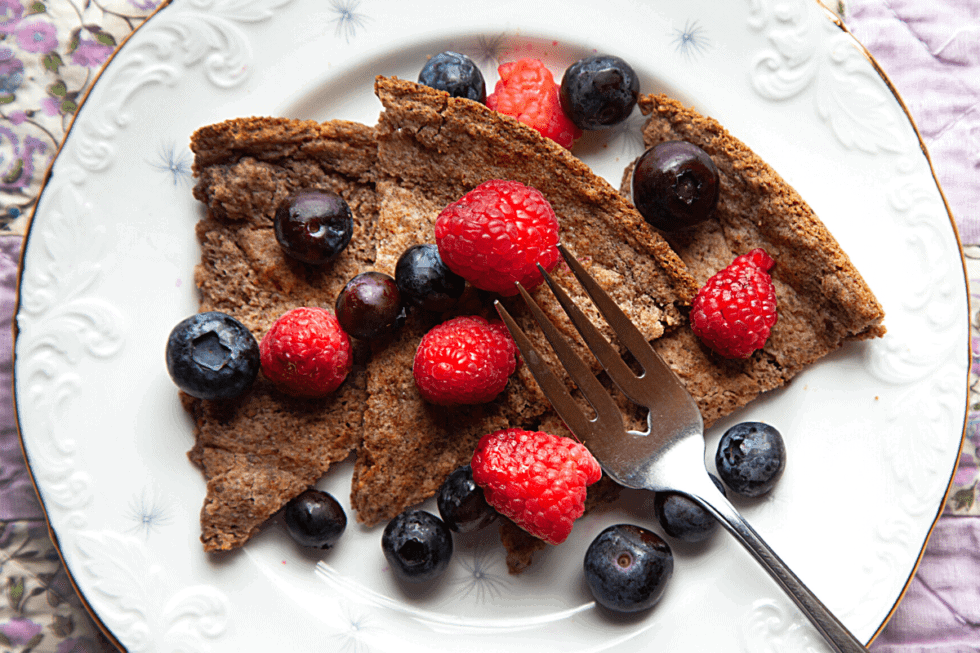
German Pancakes Brunch Recipe — Low Histamine, Low Lectin, Low Oxalate Recipe – for People with Mast Cell Activation Syndrome and Histamine Intolerance (with Low FODMAP, Low Salicylate Options)
Our Mast Cell 360 community members with Mast Cell Activation Syndrome or Histamine Intolerance regularly request breakfast recipes.
I love a good brunch on the weekends!
So, I was really excited to come across a recipe for Paleo German Pancakes on Facebook.
It was posted by my friend, Dr. Keesha Ewers. Her recipe inspired me to make this histamine and mast cell friendly version.
I really loved it! It felt kinda fancy, too. But it’s much easier than most fancy breakfast dishes!
Now, these aren’t like traditional flat pancakes. The consistency is more like custard or bread-pudding.
The recipe has endless options for toppings and mix-ins. In this recipe, I suggest blueberries or raspberries. Or apples for a low salicylate option.
When I modified this recipe, I added ingredients that can be beneficial for supporting mast cells and lowering histamine levels.
First up, let’s look at the benefits of coconut milk.
Coconut Milk – What to Know for People with Mast Cell Activation Syndrome and Histamine Intolerance

Coconut milk is a wonderful dairy substitute. It’s low histamine and mast cell friendly. But that’s only if there aren’t added thickeners or other histamine-triggering additives.
I really like and recommend the Native Forest Simple coconut milk. I get it from Amazon. You can buy it in a 6 pack. This is one of the few brands I’ve found without additives.
Coconut milk can be beneficial in a number of ways. One way is that it contains a compound called monolaurin. It’s present in the fat (coconut oil).
Coconut oil and monolaurin can have anti-fungal and possibly anti-inflammatory properties.
Monolaurin may even help fight candida overgrowth. According to some cell and animal studies, monolaurin may help break down biofilms.
Biofilms are like a shell that candida build around themselves. These “shells” help protect the candida. And that’s bad news if you have candida overgrowth. Those shells make it harder to fight off.
You can learn more about the candida-mast cell connection in this blog post.
There’s another potential benefit of coconut, too. In animal studies, coconut extract was shown to have some antioxidant and anti-inflammatory effects.
Foods and substances that lower inflammation can be helpful for stabilizing mast cells.
So coconut milk is generally a good milk substitute for those of us with Mast Cell Activation Syndrome or Histamine Intolerance.
And it’s a great source of healthy fats.
Another ingredient we’ll use in this recipe is pasture-raised eggs.
Let’s go over some other benefits of pasture-raised eggs in the next section. (There is an egg free option below, too.)
Pasture-Raised Eggs – What to Know for People with Mast Cell Activation Syndrome and Histamine Intolerance
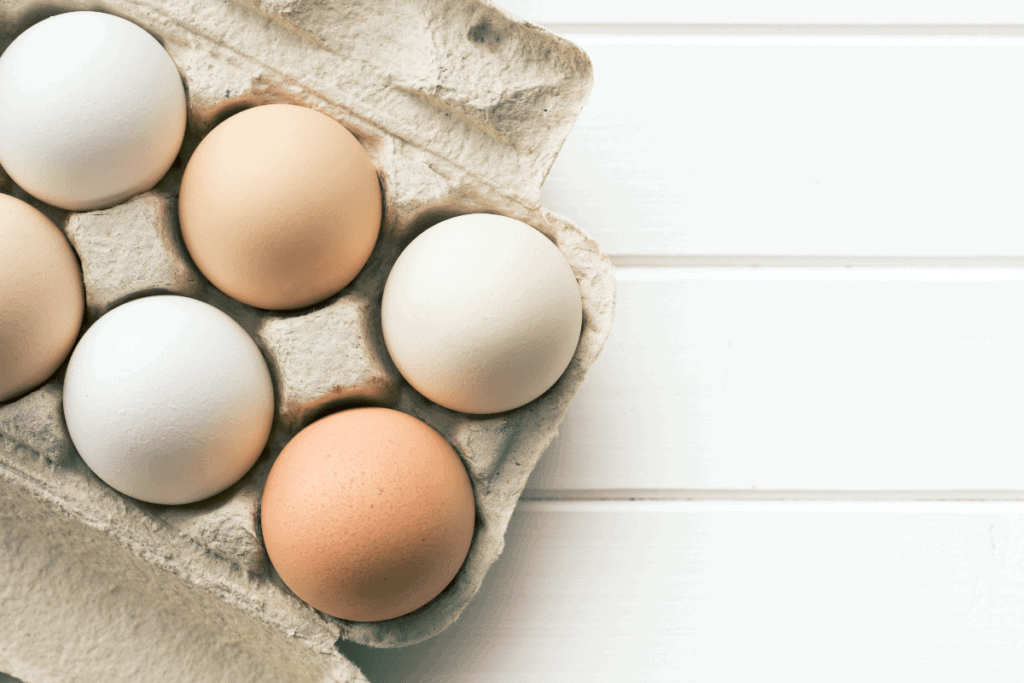
Eggs, of course, are a key ingredient in German Pancakes. They add the wonderful custardy texture. And they hold everything together.
(See below for an egg free option.)
To get the most benefit from eggs, you want to make sure you have pasture-raised eggs.
Pasture-raised eggs come from free-range chickens. Free-range chickens roam outside. So, they get fresh air, bugs, plants, and sunshine.
That contributes to healthier chickens. And the health of the chickens affects the health of their eggs.
A 2010 study compared the nutrition of pasture-raised eggs vs. conventional eggs. The pasture-raised eggs had twice the vitamin E compared to the conventional eggs. They also had 2.5 times more omega-3 fatty acids.
And omega-3 fatty acids have been shown to be anti-inflammatory in these studies. Plus, omega 3s are very important for mast cell balancing.
And, most of us with Mast Cell Activation Syndrome or Histamine Intolerance can’t use fish oil. So, if you tolerate pasture-raised eggs, these can be a good source of Omega 3s.
If you are like me, you may have trouble eating eggs sometimes. I have trouble eating 2 or more eggs at a time.
However, I seem to be okay if I only eat a small amount of egg in a recipe like this.
If you don’t do well with eggs, don’t worry! I have a substitute you can try. It’s a combination of flax eggs and applesauce.
If you haven’t made flax eggs before, it’s easy. Directions are included at the bottom of the recipe.
The soaked flax thickens the batter. The recipe won’t rise as much. It will be thinner, like a crepe. But it will still have a custardy middle and taste great.
For our next ingredient options, let’s look at blueberries and raspberries.
These berries go really well with this recipe. They also have great potential benefits for supporting you if you have Mast Cell Activation Syndrome and Histamine Intolerance.
We’ll talk about those, next.
Blueberries & Raspberries – What to Know for People with Mast Cell Activation Syndrome and Histamine Intolerance
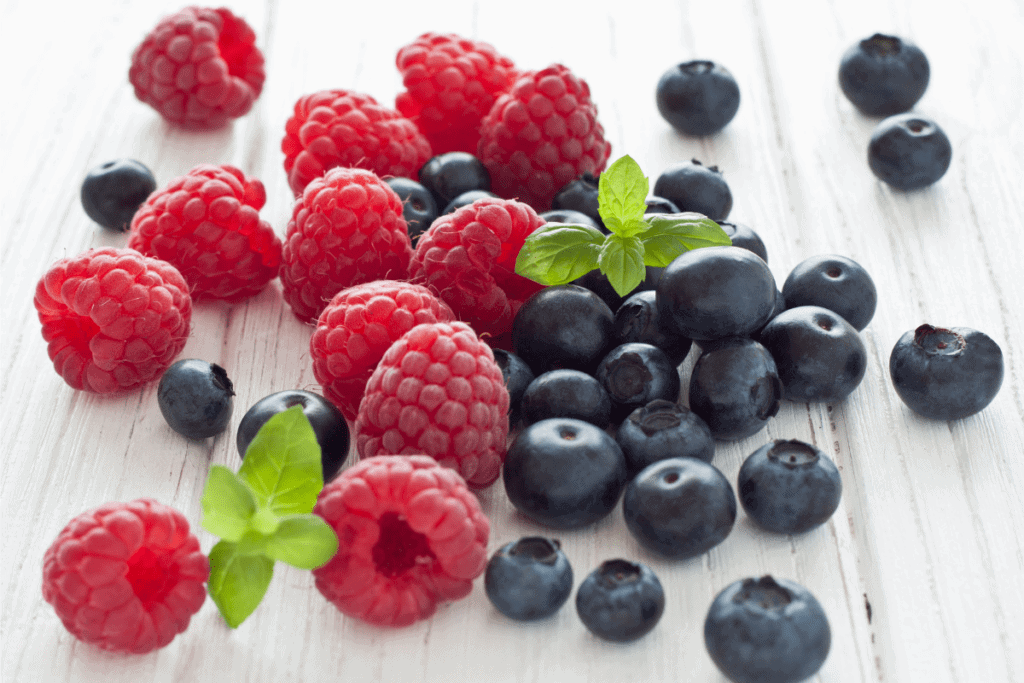
Blueberries and raspberries are a great topping for this German Pancake recipe. And they are a good option for many of us with Mast Cell Activation Syndrome or Histamine Intolerance.
Blueberries and raspberries are rich in quercetin. Quercetin is a natural antihistamine.
Blueberries also contain a compound called pterostilbene. According to cell studies conducted in 2014 and 2015, pterostilbene was found to be an anti-inflammatory compound.
Raspberries are a lower FODMAP option than blueberries. And even though they are a little higher histamine… they also contain histamine-lowering ellagic acid and quercetin. For many, this balances out some of the histamine.
(If you’re super histamine intolerant, though, you may need to stick with blueberries until your histamine levels are improved.)
And these berries contain polyphenol. Generally, these help to lower inflammation, too.
A 2018 study discussed how blueberries were helpful for preventing heart disease. That was in part because of how the polyphenols helped lower inflammation.
The polyphenols are extremely beneficial to gut health, too. Research published in the Journal of Agricultural and Food Chemistry showed that polyphenol-rich foods improved levels of bifidobacteria and lactobacilli — good bacteria in the gut. And these beneficial polyphenols protect against the bad bacteria, too.
If you need to be low salicylate, however, you’ll need to skip the berries. You can use peeled yellow delicious apples instead as a topping.
So, next let’s talk about sweeteners.
In general, sugars contribute to inflammation. In part, that’s because they raise blood sugar. We don’t want that.
You can read more about the problems with sugar and mast cell activation here.
The solution? A sweetener that doesn’t raise your blood sugar. Like monk fruit.
This is my “go-to” sweetener for Mast Cell Activation Syndrome and Histamine Intolerance. I’ll talk about some of the benefits of this sweetener next.
Monk Fruit – What to Know for People with Mast Cell Activation Syndrome and Histamine Intolerance
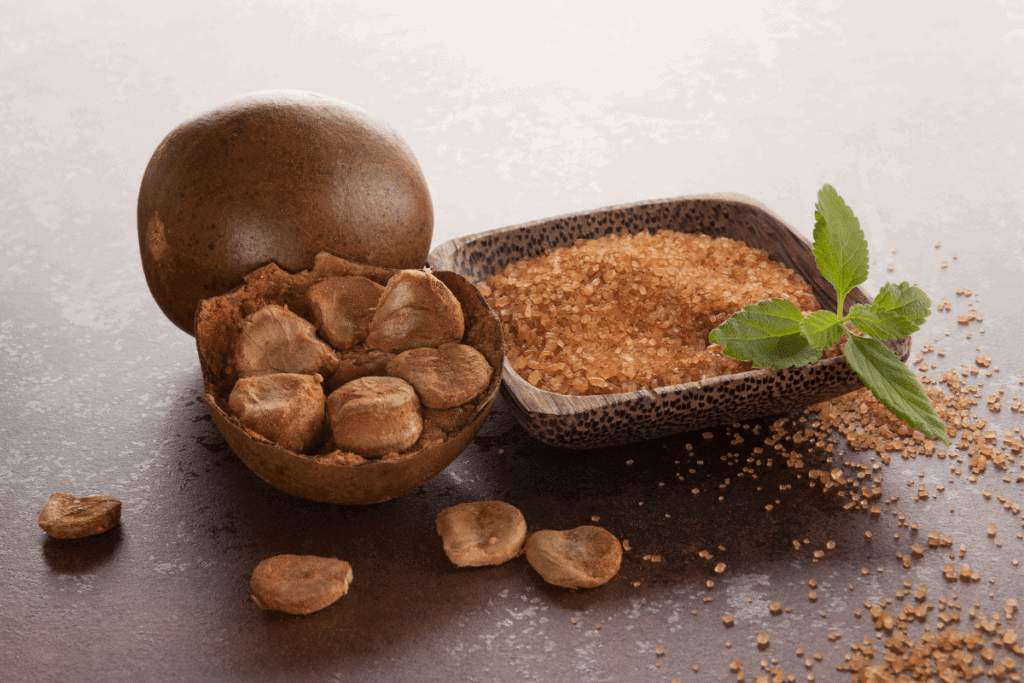
Monk fruit is my sweetener of choice for Mast Cell Activation Syndrome or Histamine Intolerance.
Monk fruit is a calorie-free sweetener. It comes to us from southern China. It’s also known as lo han guo. Monk fruit has been used in China for over 1,000 years.
You have to be careful about brands, though! The majority of monk fruit sweeteners have additives like erythritol — a sugar alcohol. That’s why I use Pure Monk Fruit Extract. It’s additive free.
The great thing about monk fruit is that it doesn’t raise blood sugar levels. And you don’t need much. It’s about 100-250 times sweetener than sugar.
Monk fruit has some compounds called mogrosides. In animal studies, these mogrosides have been found to be anti-inflammatory. Which can help histamine levels and mast cells.
So, it’s a great option if you have Mast Cell Activation Syndrome or Histamine Intolerance.
German pancakes are traditionally loaded with sugar. But the monk fruit gets around that.
German pancakes are also usually flavored with warming spices like cinnamon, nutmeg, or allspice. The trouble is… these are all high histamine.
So, how do we get that kind of warming spice flavor without the high histamine? I’ll go over my delicious spice blend next. And it can be a histamine-buster – which is a big bonus!
Camu Camu & Cardamom – What to Know for People with Mast Cell Activation Syndrome and Histamine Intolerance
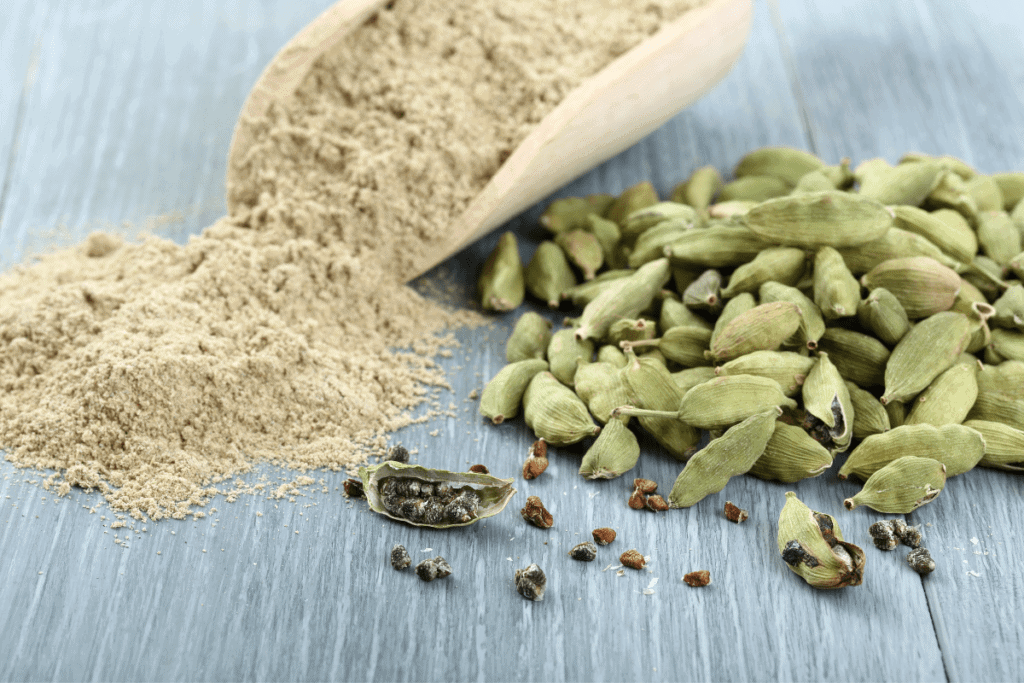
Camu camu and cardamom. These two ingredients might sound like an odd addition to German Pancakes. Especially since camu camu is usually taken as a vitamin C supplement.
However, this combination has a specific purpose.
Traditional German Pancakes often call for spices like cinnamon, nutmeg, or allspice. Unfortunately, those spices are histamine liberators.
The good news is that there is a delicious substitute. Camu camu and cardamom add a flavor that is much like nutmeg and allspice. AND they can help support mast cells.
Cardamom has a similar taste profile as ginger, cloves, cinnamon, and nutmeg. It’s also slightly sweet. The camu camu has a mild, slightly sour taste. And it tastes a bit like allspice.
Combined, these two are magic. The camu camu brightens the cardamom flavor. The result is a delicious warming spice flavor in your German pancake. I’ve even served it to my family. They couldn’t tell I subbed this in for the other spices!
Let’s look at the benefits of camu camu and cardamom.
Camu camu provides antihistamine vitamin C. And cardamom has anti-inflammatory properties.
In a 2017 study of women with inflammation and blood sugar issues, cardamom supplementation lowered markers of inflammation. Including the inflammation marker C-reactive protein.
Are you looking forward to trying Camu Camu as a mast cell supporting spice or a supplement?
Make sure to get an organic camu camu. Choose a reliable brand. You want to be sure it is free of pesticides and other toxins. I use Navitas Camu Camu powder.
However, if you have salicylate intolerance, you’ll have to avoid Camu Camu and cardamom. There aren’t really any low salicylate spices to sub. So, one idea is to do a savory version of this recipe. And add herbs like garlic and chives instead.
Or just skip the cardamom and camu camu. It will still be great without the spices and topped with low salicylate red or golden delicious peeled apples.
However you make it, this recipe does go really well with coffee. I’ll share my low histamine coffee of choice in the next section! It was a morning game changer for me!
Low Histamine Coffee – What to Know for People with Mast Cell Activation Syndrome and Histamine Intolerance

This German Pancake recipe goes great with Purity Coffee. Purity is the only coffee brand I’ll drink. I won’t even drink any other organic coffee brands.
So why don’t I drink other coffee brands?
Well, first 99% of coffee out there is very high histamine from fermentation. And worse, 99% of coffee is full of toxins. Especially mold toxins! And pesticides!
Even the organic brands are loaded with mold toxins. This isn’t something organic certifications test for. It’s especially high in Ochratoxin.
So, why Purity Coffee? It’s organic and it’s mold-free. It’s also low salicylate, low FODMAP, low oxalate and low lectin.
Plus it’s low acid, so it’s gentler on your stomach.
And it’s absolutely delicious! I’m a coffee snob. And I really love this coffee.
You can get traditional caffeinated Purity Coffee. Or you can get their organic 99.9% decaf version. This is the one I drink.
I stick with the decaf since my body has trouble with caffeine. Most decaf coffee still has a bit of caffeine. The Purity Coffee is the only decaf I’ve tolerated.
Learn more about The Secret to Coffee If You Have Mast Cell Activation or Histamine Intolerance here.
But if you’re ready to have coffee with brunch…
>>>> Get 20% off Mold-free, Low Histamine Purity Coffee Here
Use the link above with coupon code MASTCELL360 for 20% off and free shipping
So, are you hungry yet? The recipe is up next!
Low Histamine, Low Lectin, Low Oxalate German Pancakes Brunch Recipe - for People with Mast Cell Activation Syndrome and Histamine Intolerance (with Low FODMAP, Low Salicylate Options)
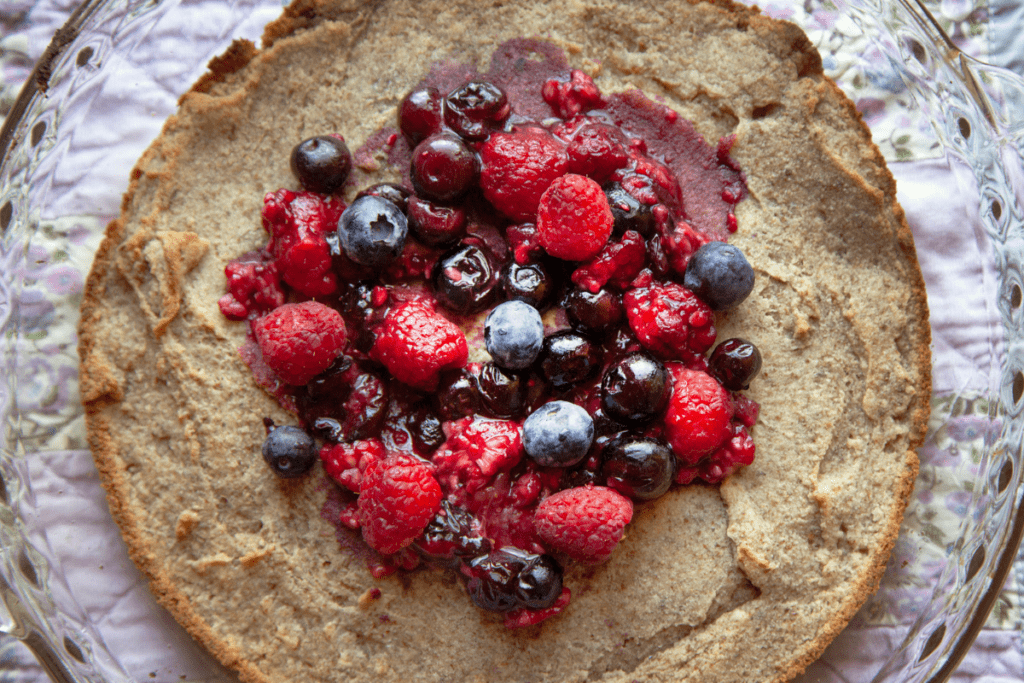
German Pancake Ingredients:
- 1 1/2 Tablespoons ghee or coconut oil (use ghee for low salicylate)
- 6 large pasture raised eggs (or sub flax eggs*)
3/4 cup Coconut Milk (sub pecan milk** for lower salicylate) - 3 Tablespoons plus 1/2 teaspoon arrowroot flour
- 3 Tablespoons coconut flour*** (see note below) (sub Organic White Rice Flour* for lower salicylate)
- 1/2 Tablespoon raw unfermented vanilla bean powder (omit for lower salicylate)
- 1 teaspoon Pure Monk Fruit Extract (sub 2 tablespoons maple syrup for lower salicylate)
- 5-10 drops Better Stevia (omit for lower salicylate)
- dash Redmond Real Salt
- 2 cardamom pods (omit for lower salicylate)
- 1 teaspoon Camu Camu Powder (omit for lower salicylate)
Topping Ingredients:
- Organic raspberries and/or organic blueberries (sub peeled, diced red or yellow delicious apples for low salicylate)
- 1 teaspoon 100% Pure Monk Fruit Extract powder (sub 2 tablespoons maple syrup for lower salicylate)
- 15 drops Better Stevia (omit for low salicylate)
- Extra 100% Pure Monk Fruit Extract powder (omit for low salicylate)
For low FODMAP, limit these to:
Blueberries – a heaping 1/4 cup per serving
Raspberries – up to 30 per serving. However if super histamine intolerant, stay with 1/4 cup raspberries or blueberries alone.
Directions:
- Preheat oven to 425 degrees F.
- Add coconut oil or ghee to a 9×13 inch baking dish. Place in the oven while it preheats. The oven will put off just enough heat to liquify the oil.
- Blend all other German pancake ingredients in a blender until well combined.
- Pour German pancake mixture into pan on top of melted oil. Bake for 20-25 minutes, until set in the middle and corners are slightly browned and puffy. Test by inserting a toothpick and seeing if it comes out clean, but don’t let it overcook. Texture will be a little like bread pudding or custard.
- While the pancake is baking, add fruit and sweetener for the topping into a small saucepan. Turn burner on medium-low heat. Cook until the fruit is warm and softened.
- Once the pancake is done, remove from oven and let sit for 5 minutes.
- Cut into pieces and serve on a plate, topped with fruit topping.
- Use a sifter and lightly sift some monk fruit sweetener on top. (Like you would with powdered sugar)
- Enjoy and freeze those leftovers! They reheat well.
Flax and Applesauce Egg Substitute: (If you can’t tolerate eggs, you might consider this as an option instead. It will be higher FODMAP.)
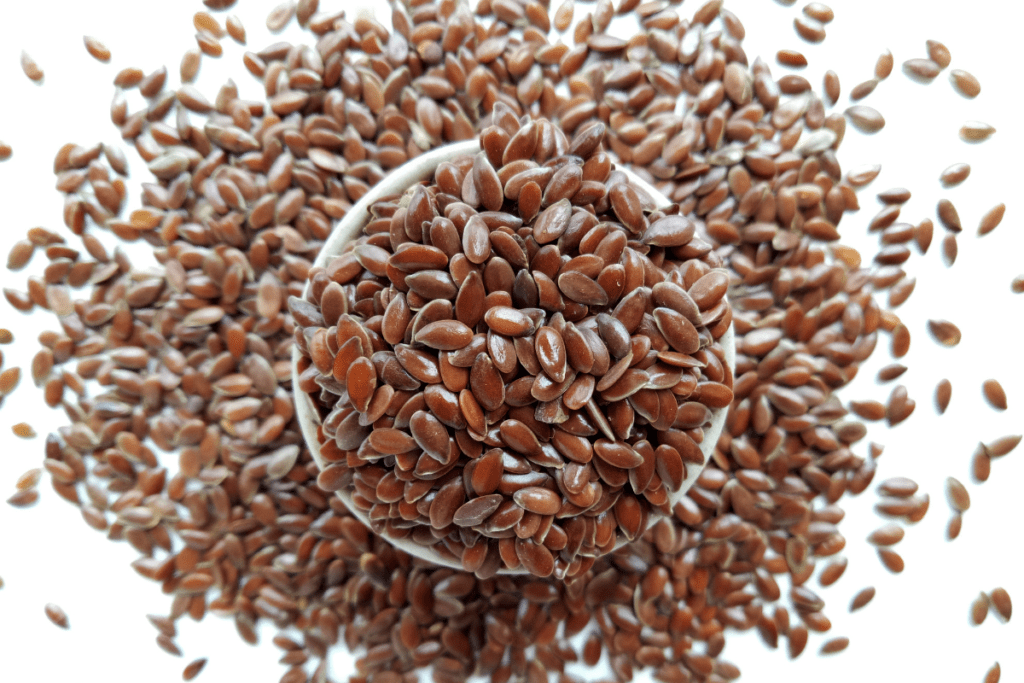
You’ll be replacing 1 egg with freshly made applesauce. Then, you’ll make flax eggs for the remaining 5 eggs.
The applesauce adds moisture and lightness.
The flax eggs help thicken the batter and bind the ingredients together. This replaces the binding properties of the eggs.
You’ll also be adding some cassava flour to help thicken the batter. I only use Otto’s as it is the only one that isn’t fermented. It has been much better tolerated by most with mast cell and histamine issues.
(A note about Otto’s Cassava flour:
Otto’s is lower in oxalates than the other brands I’ve tried. But it still has medium to high oxalates. It depends on how much you eat as to whether it will be considered medium or high.
If you have severe oxalate issues, even Otto’s Cassava might be too much.)
Using the egg substitutes means your German pancakes will be thinner with a custard-like center. It may not look exactly the same. But it still tastes pretty good!
Ingredients for Egg Substitute:
- 1 large organic golden delicious apple, peeled
- 5 tablespoons flax meal
- 3 tablespoons Otto’s Cassava flour
- 5 tablespoons filtered water
Directions for Egg Substitute:
- Peel and dice apple. Blend in a blender or food processor until the consistency of thick applesauce.
Measure out ¼ cup applesauce.
- Mix 5 tablespoons of flax meal with 5 tablespoons of water. Let it sit for 5 minutes. Add slightly more water if needed to reach a paste-like thickness.
- Add 1/4 applesauce, the flax eggs, and 3 tablespoons of to the batter at step 3 in the recipe above in place of the eggs.
Please note that you won’t get as much rise as you would with eggs. It will be slightly thicker than a crepe. But the middle will still have a texture like custard or bread-pudding.
How to Make Pecan Milk (higher oxalate than coconut milk but low salicylate)
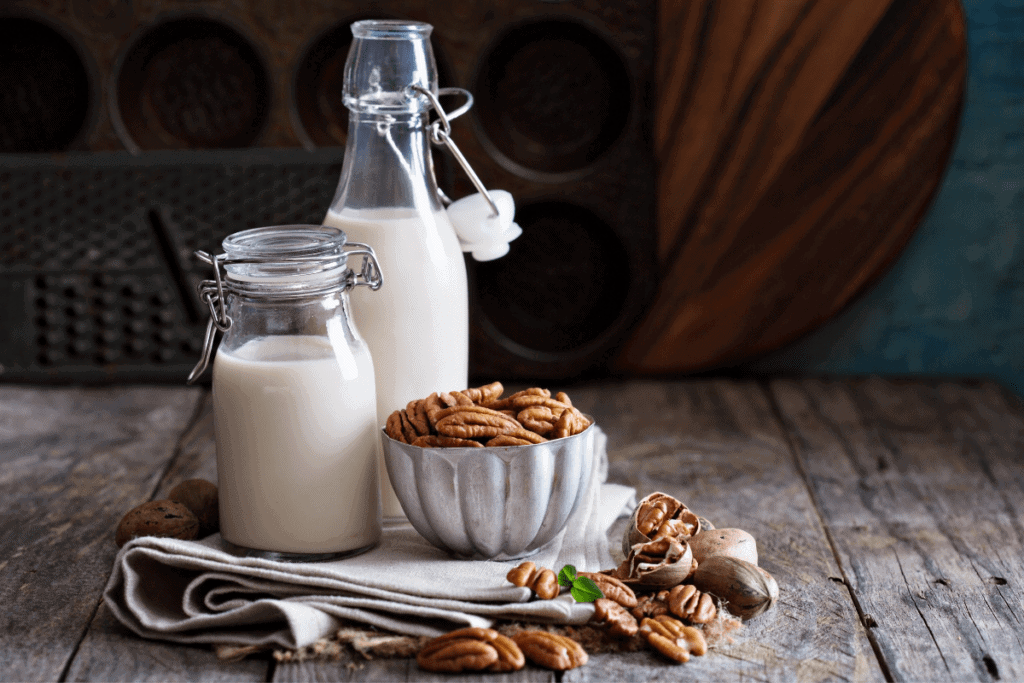
Pecans can be high in mold toxins. To reduce them, we’re first going to soak the pecans in salt water. That will also help make them more digestible.
- Add several cups Pesticide Free Pecans to a large bowl.
- Cover with filtered water. Add just enough water to cover the pecans.
- Add 1 cup Redmond Real Salt. Stir until dissolved.
- Put the bowl in the fridge.
- Allow pecans to soak for 8-10 hours.
- Drain and rinse.
- Spread the pecans on cookie sheet(s). Then place in the oven at 250 degrees F. Heat them 1-2 hours until dry and crispy. Or you can place them in a food dehydrator. Dry until crispy.
Store the dried pecans in fridge. I like to make a big batch of soaked and dried pecans at a time. I usually do 2-3 lbs at once to keep on hand for snacking or recipes.
To make pecan milk:
- Place 1/2 cup of the pecans in a blender or food processor.
- Add ¾ cup filtered water.
- Blend until pecans are liquified.
- Strain and use in place of the coconut milk above.
Let me know if you make this recipe. I’d love to hear what you think in the comments below!
***Coconut flour can be higher histamine if it’s been dried and on a shelf for a long time, so if you’re extremely histamine intolerant, you’ll want to make sure it’s fresher or sub with rice flour.
*Some links in this website are affiliate links, which means Mast Cell 360 may make a very small commission if you purchase through the link. It never costs you any more to purchase through the links, and we try to find the best deals we can. We only recommend products that we love and use personally or use in the Mast Cell 360 practice. Any commissions help support the newsletter, website, and ongoing research so Mast Cell 360 can continue to offer you free tips, recipes, and info. Thank you for your support!
References For German Pancakes Brunch Recipe -- Low Histamine, Low Lectin, Low Oxalate Recipe - for People with Mast Cell Activation Syndrome and Histamine Intolerance (with Low FODMAP, Low Salicylate Options)
Choi, Y. H., & Yan, G. H. (2009). Ellagic Acid attenuates immunoglobulin E-mediated allergic response in mast cells. Biological & pharmaceutical bulletin, 32(6), 1118–1121. https://doi.org/10.1248/bpb.32.1118
Cleveland Clinic. (2019). Sugar Substitutes & Non-Nutritive Sweeteners. Cleveland Clinic Health Library. Last reviewed January 16, 2019. Accessed April 6, 2021 from: https://my.clevelandclinic.org/health/articles/15166-sugar-substitutes–non-nutritive-sweeteners
Di, R., Huang, M. T., & Ho, C. T. (2011). Anti-inflammatory activities of mogrosides from Momordica grosvenori in murine macrophages and a murine ear edema model. Journal of agricultural and food chemistry, 59(13), 7474–7481. https://doi.org/10.1021/jf201207m
Intahphuak, S., Khonsung, P., & Panthong, A. (2010). Anti-inflammatory, analgesic, and antipyretic activities of virgin coconut oil. Pharmaceutical biology, 48(2), 151–157. https://doi.org/10.3109/13880200903062614
Karsten, H., Patterson, P., Stout, R., & Crews, G. (2010). Vitamins A, E and fatty acid composition of the eggs of caged hens and pastured hens. Renewable Agriculture and Food Systems, 25(1), 45-54. doi:10.1017/S1742170509990214
Karunasiri, A. N., Gunawardane, M., Senanayake, C. M., Jayathilaka, N., & Seneviratne, K. N. (2020). Antioxidant and Nutritional Properties of Domestic and Commercial Coconut Milk Preparations. International journal of food science, 2020, 3489605. https://doi.org/10.1155/2020/3489605
Kazemi, S., Yaghooblou, F., Siassi, F., Rahimi Foroushani, A., Ghavipour, M., Koohdani, F., & Sotoudeh, G. (2017). Cardamom supplementation improves inflammatory and oxidative stress biomarkers in hyperlipidemic, overweight, and obese pre-diabetic women: a randomized double-blind clinical trial. Journal of the science of food and agriculture, 97(15), 5296–5301. https://doi.org/10.1002/jsfa.8414
Naskar, S., Mazumder, U. K., Pramanik, G., Saha, P., Haldar, P. K., & Gupta, M. (2013). Evaluation of antinociceptive and anti-inflammatory activity of hydromethanol extract of Cocos nucifera L. Inflammopharmacology, 21(1), 31–35. https://doi.org/10.1007/s10787-012-0135-7
Ogbolu, D. O., Oni, A. A., Daini, O. A., & Oloko, A. P. (2007). In vitro antimicrobial properties of coconut oil on Candida species in Ibadan, Nigeria. Journal of medicinal food, 10(2), 384–387. https://doi.org/10.1089/jmf.2006.1209
Rong Di, Mou-Tuan Huang, and Chi-Tang Ho. (2011). Anti-inflammatory Activities of Mogrosides from Momordica grosvenori in Murine Macrophages and a Murine Ear Edema Model. Journal of Agricultural and Food Chemistry, 59(13), 7474-7481
DOI: 10.1021/jf201207m
Sato, D., Shimizu, N., Shimizu, Y., Akagi, M., Eshita, Y., Ozaki, S., Nakajima, N., Ishihara, K., Masuoka, N., Hamada, H., Shimoda, K., & Kubota, N. (2014). Synthesis of glycosides of resveratrol, pterostilbene, and piceatannol, and their anti-oxidant, anti-allergic, and neuroprotective activities. Bioscience, biotechnology, and biochemistry, 78(7), 1123–1128. https://doi.org/10.1080/09168451.2014.921551
Seleem, D., Chen, E., Benso, B., Pardi, V., & Murata, R. M. (2016). In vitro evaluation of antifungal activity of monolaurin against Candida albicans biofilms. PeerJ, 4, e2148. https://doi.org/10.7717/peerj.2148
Seleem, D., Freitas-Blanco, V. S., Noguti, J., Zancope, B. R., Pardi, V., & Murata, R. M. (2018). In Vivo Antifungal Activity of Monolaurin against Candida albicans Biofilms. Biological & pharmaceutical bulletin, 41(8), 1299–1302. https://doi.org/10.1248/bpb.b18-00256
Shimoda, K., Kubota, N., Uesugi, D., Hamada, H., Tanigawa, M., & Hamada, H. (2015). Synthesis and pharmacological evaluation of glycosides of resveratrol, pterostilbene, and piceatannol. Annals of the New York Academy of Sciences, 1348(1), 141–149. https://doi.org/10.1111/nyas.12836
Silva, R. R., Oliveira e Silva, D., Fontes, H. R., Alviano, C. S., Fernandes, P. D., & Alviano, D. S. (2013). Anti-inflammatory, antioxidant, and antimicrobial activities of Cocos nucifera var. typica. BMC complementary and alternative medicine, 13, 107. https://doi.org/10.1186/1472-6882-13-107
Tuohy, K. M., Conterno, L., Gasperotti, M., & Viola, R. (2012). Up-regulating the human intestinal microbiome using whole plant foods, polyphenols, and/or fiber. Journal of agricultural and food chemistry, 60(36), 8776–8782. https://doi.org/10.1021/jf2053959
Wu, X., Wang, T., Prior, R. L., & Pehrsson, P. R. (2018). Prevention of Atherosclerosis by Berries: The Case of Blueberries. Journal of agricultural and food chemistry, 66(35), 9172–9188. https://doi.org/10.1021/acs.jafc.8b03201



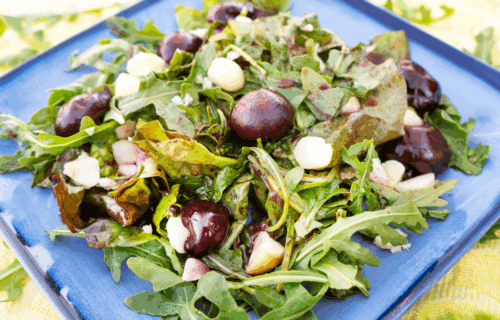
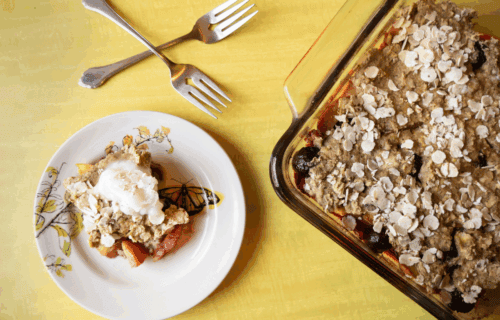

Thank you for these and for including the salicylate warnings as so often Histamine sites ignore or just do not know about the salicylate in foods which is so frustrating. Thank you thank you.
I read that you have a list of low oxalate and low salicylate foods for clients but you do not recommend doing so initially. I am pretty sure that my extreme sensitivities extend to oxalates and salicylates, too. Will you please send me these food list pdf’s? I would be forever thankful.
Hi Jacob, I sent the info to the email you have listed here with the account you commented with. Check your spam folder, too, if you don’t see it in your inbox.
Best wishes!
Hi Suz,
Can you please send me the same info as Jacob? Thank you!!
Hi Scott,
We know have all our food lists in one easy to find place online: https://mastcell360.com/food-lists/
Hope this helps!
Hi Beth,
I am just curious as to what brands of Coconut Flour are safest as you suggest it can be high in histamine due to storage etc. and is there any other alternative other than white rice flour as it is high in lectins from my understanding.
Thanks
Here is the brand of coconut flour we typically recommend: https://amzn.to/42Bvu3o. It can be higher histamine due to long storage on the shelves, so typically avoided if super sensitive to histamine, but it may be something you can use once you’ve lowered your histamine load after some time.
Rice flour is higher in lectins, this recipe has only been tested with coconut and rice flour, but if you are lectin sensitive, you may be interested in some of these other low lectin recipes found on the website: https://mastcell360.com/category/recipes/low-lectin/
If you do try this recipe with other flour options, we’d love to hear how they turned out! You can find other low histamine options on our main food list here: https://mastcell360.com/low-histamine-foods-list/
Thank you Jamie.